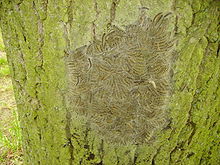Processionary moth
| Processionary moth | ||||||||||
|---|---|---|---|---|---|---|---|---|---|---|

Pine processionary moth ( Thaumetopoea pityocampa ) |
||||||||||
| Systematics | ||||||||||
|
||||||||||
| Scientific name | ||||||||||
| Thaumetopoeinae | ||||||||||
| Aurivillius , 1889 or 1891 |

The processionary moths (Thaumetopoeinae) are a subfamily of the toothed moth (Notodontidae), which belong to the order of butterflies (Lepidoptera). About 100 species of them are known from the Old World , which occur mainly in Africa, the Mediterranean region and southern Europe and east to India and Australasia . The processionary moths are considered by some authors as a separate family (Thaumetopoeidae). You are in a sister relationship to all other tooth spinners.
features
Although the moths of the individual species differ considerably in appearance, there are some characteristic features: sclerotized forehead protrusions and an anal bursa copulatrix (mating pouch ) at the end of the abdomen of the females.
Your proboscis has receded or is completely absent. The labial palps are also mostly regressed and small. The antennae of both sexes are heavily combed.
The caterpillars are covered with stinging stinging hairs . In contrast to the short hair, the long hair is harmless. The latter can penetrate the human skin, where they cause severe allergic reactions. The caterpillars are also called nettle caterpillars, hair caterpillars, nettle worms or train caterpillars.
Way of life
The caterpillars feed on a multitude of different plants, but these are mainly dog-poison plants (Apocynaceae), legumes (Fabaceae), myrtle plants (Myrtaceae) and sterculia plants (Sterculiaceae). Some species live together, sometimes in webs. At night they look for food and walk one after the other in processions. That is why the subfamily has its German name. You can also watch these caterpillars lined up one behind the other during the day.
The reason for the chaining of the individual caterpillars in a row is probably that the caterpillars appear as a snake in the formation for predators (birds) and are therefore not recognized by them as food. This type of camouflage is called mimicry .
Pupation takes place in a dense cocoon , which in the species of the genus Anaphe are woven into large webs.
Certain species can cause damage if they occur heavily, which is why they are systematically controlled in some areas.
Dangers from processionary moth caterpillars
The very fine stinging hairs of the caterpillar, which contain a poison, can cause caterpillar dermatitis . In humans, they can cause severe skin irritation and allergies, asthma, etc., in dogs, if they come into contact with the nose and snout, they can cause severe snout poisoning.
Systematics
In Europe there are six species of processionary moth, three of which are also found in Central Europe:
- Helianthocampa herculeana ( Thaumetopoea herculeana ) (Rambur, 1840)
- Oak processionary moth Thaumetopoea processionea (Linnaeus, 1758)
- Pistachio processionary moth Thaumetopoea solitaria (Freyer, 1838)
- Pine processionary moth Thaumetopoea pinivora (Treitschke, 1834)
- Pine processionary moth Thaumetopoea pityocampa (Denis & Schiffermüller, 1775)
- Thaumetopoea wilkinsoni Tams, 1926 The taxonomic status of the species is unclear, presumably it is a subspecies of Thaumetopoea pityocampa .
Non-European species (selection)
- Cedar processionary moth Traumatocampa bonjeani (Powell, 1922)
swell
Individual evidence
- ↑ Malcolm J. Scoble: The Lepidoptera: Form, Function and Diversity . Oxford University Press, Oxford 1995, ISBN 0-19-854952-0 (English).
- ↑ a b Niels P. Kristensen: Lepidoptera, moths and butterflies . In: Maximilian Fischer (Ed.): Handbook of Zoology . 1st edition. tape 4 - Arthropoda: Insecta , volume 35. de Gruyter, Berlin / New York 1998, ISBN 3-11-015704-7 (English).
- ↑ Thaumetopoeinae. Fauna Europaea, Version 1.3, April 19, 2007, accessed January 14, 2008 .

